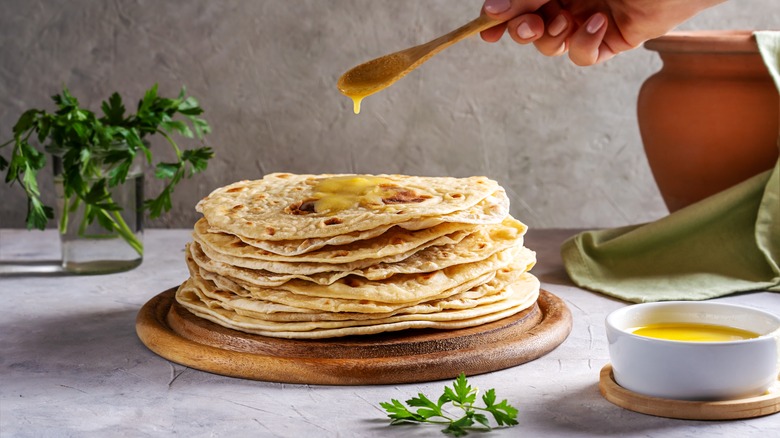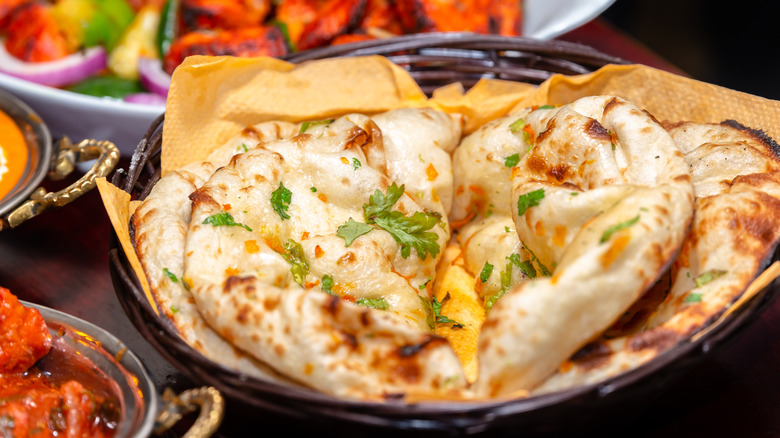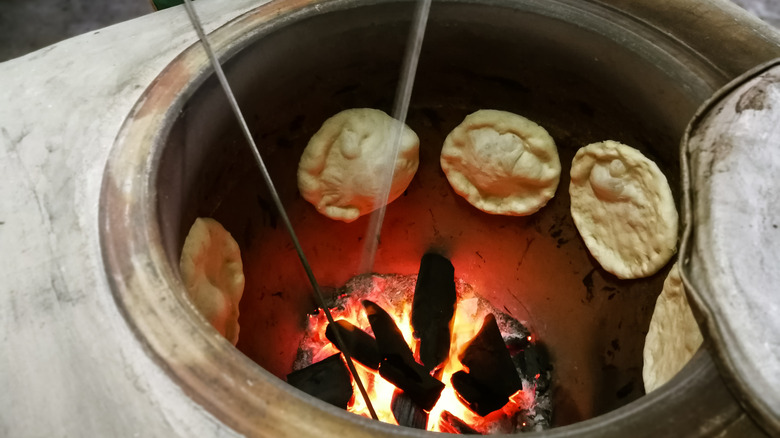The Key Difference Between Naan And Roti Bread
There are hundreds of breads around the world, and South Asia alone is home to a few dozen of these — so many that they are often confused with one another. Deep-fried pooris are mistaken for puffy bhatooras, stuffed parathas for flaky parottas, fluffy kulchas for pillowy naans, and naans for flat rotis. Though they may seem similar, there are several differences between these flatbreads, especially when it comes to naan and roti.
The most distinguishing difference between naan and roti is that the former is a leavened bread, while the latter is not. Naan uses leavening agents such as yeast, baking soda, or baking powder for its thick but soft and tender texture. On the other hand, roti is typically made from a simple mix of flour and water, giving it a more dense and flat appearance.
The confusion between naan and roti perhaps stems from the way they are prepared. Traditionally, naans are cooked in large, urn-shaped clay ovens known as tandoors, and rotis on flat griddles or pans known as tawas on the stove. However, there is a version of the flatbread called tandoori roti that is cooked in a tandoor too. Plus, with the absence of bulky tandoors in modern-day kitchens, naans can also be cooked much the same way as rotis — in hot pans on the stove.
Naan and roti differ in ingredients as well
While it is possible to cook naan and roti in the same way, they differ in their ingredients. Roti is typically made from whole wheat flour, whereas naan can be made from whole wheat or all-purpose flour, or even a mix of both. Additionally, while roti's ingredients are simple, including flour, water, salt, oil, and sometimes cumin or carom seeds, naan dough may be kneaded with buttermilk. The acid in buttermilk activates leavening agents like baking soda, and imparts a distinct tartness to naan, a flavor that's absent in roti.
However, the ingredients for rotis and naans can vary greatly by region. For instance, in northern India, maize flour is used for makki ki roti, while rice flour is preferred for akki roti in the south. Roti also varies internationally — it can be stuffed with spiced lentils to make Caribbean dhal puri, or be flipped, stretched, and tossed to create the incredibly flaky Malaysian roti canai.
Similarly, naan varies widely: Peshawari naan, filled with nuts and coconut, originates from Peshawar, while roghni naan, sprinkled with sesame and nigella seeds, is popular in Afghanistan. Naans can be topped with buttery garlic, an excellent alternative for grilled cheese bread, or stuffed with spiced, minced meat.
Roti's origins are not clear
Naan derives its name from the Persian word nân-e sangak, meaning bread cooked on pebbles, with its earliest mention traceable to 1300 C.E. when Indo-Persian poet Amir Khosrow discussed the flatbread in his writings, establishing it as an essential Iranian dish. Naan eventually made its way to the Indian subcontinent, where it became a favored accompaniment for kebabs among the Mughals. At that time, the leavened flatbread's time-intensive preparation method rendered it a delicacy reserved for the upper echelons of society. It was not until the 1700s that this soft flatbread became popular in households beyond the nobility, and its appeal started to spread across borders.
The origins of roti, however, are less clear. Some theorize that roti also has Persian roots, and was initially made from all-purpose flour. Others argue that roti's origins can be traced back to East Africa, where wheat and leavening agents were already used to make flatbreads. Yet, historians find mentions of roti in texts dating back to the Harappan civilization millennia ago, as well as in ancient religious and medicinal scripts, suggesting its origins are deeply embedded in the Indian subcontinent. Roti gained prominence in the Mughal court, where its lightness and the ability to remain fresh even when cold made it an ideal side for curries — a popularity that continues today.



